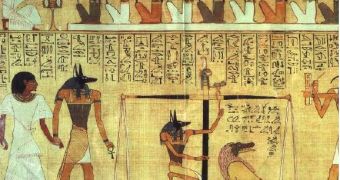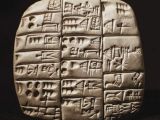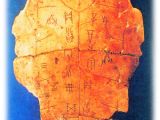For humans, writing meant a huge technological and cultural revolution. Information was at last to be recorded in a more secure way than via human memory. Writing and reading seem natural for us, but they had to be invented and perfected.
In 1996, on the left bank of the Euphrates River, 100 km (60 mi) of Aleppo (Syria), in the archaeological site of Jerf el-Ahmar (in Arabian "Red Bank"), a Syrian-French team discovered some very odd stone slates bearing engraved graphics.
The plates were considered to date from the Neolithic (New Stone Age), being 9,000 years old! The plates pre-date by 4,000 years the oldest previously known writing from Sumer (in southern Iraq), believed to have appeared 5,000 years ago.
The mysterious graphics combine or associate animal figures (quadrupeds or prey birds) with abstract signs: a sinuated line ended on an arrow or a cross. People were known to have used animal figures or abstract signs previously to that date, but they were discovered for the first time to be associated in various compositions, making what researchers call pictograms: mnemotechnical (memory involving) representations, a kind of graphic resume alluding to a story. They may not represent actual writing, which is always the linguistic formulation of a structured thinking, but these plates predetermined the Sumerian writing.
Decoding those plates could be impossible, as a "Rossette stone," like that employed by Champollion to decode the Egyptian hieroglyphs, does not exist.
Scientists consider that the first sketches of a graphic system appeared when a civilization reached an economic and intellectual level that made necessary the need to organize, in a way or another, the actual facts of daily life but also the abstract ones, linked to concepts and beliefs.
As a phenomenon, the writing is not unique in time and space. Writing systems were spontaneous phenomena, most of them independent one from another, in various points of the world at various times.
The first stage was that of primitive signs, isolated marks, made spontaneously, as notches, knots or lines, sometimes even as sketches, announcing the first pictograms. These signs characterize the hunters-gatherers - like the Paleolithic (old stone age) cave wall paintings - but they are still being employed today by some Amerindians of South America or Australian Aborigines.
The second stage is that of the symbolic writing: sketches are more complex, encoding messages. Walking can be expressed by two walking feet, giving by an extended hand, and so on. This stage is characteristic for agricultural societies and expresses a new attitude toward the Universe, being correlated with the first religious representations. Agriculture emerged and spread in the Middle East 9,000 years ago (exactly the place and the age of the Jerf el-Ahmar plates) and spread to Danube valley around 7,500 years ago and to the western Europe 7,300 years ago. It is now when people started to trace signs on clay tablets.
The third stage in the development of the writing passes through the urban revolution of Sumer (6,000 to 3,000 years ago) and Egypt, in a hierarchical social organization and booming economy, when the ideographic writing appeared: the Sumerian cuneiform writing and the Egyptian hieroglyphs. These people knew medicine, used currencies, channeled the rivers and developed a flourishing agriculture.
It seems that the cuneiform writing appeared as a necessity of counting the number of livestock, wheat and barley reserves. It originated in the symbolic writing, in which an ox head represented an ox, a wheat ear represented crop. Symbols were used for expressing ideas. An egg next to a bird meant "breeding". The clay tablets could preserve the information for long periods. In time, the signs grew in number and could express increasingly more ideas.
The Sumerian cuneiform tablets date from 3,500 BC. The Egyptian hieroglyphs developed between 3,000-2,500 BC. The Egyptian hieroglyphs ("sacred image" in Old Greek) are drawings combined for transmitting ideas and sounds. Egyptians believed the hieroglyphs were a gift from the gods and had magical value.
The most important stage in writing history is represented by the development of the alphabetical writing. This writing targets isolated sounds, that's why it can be adapted to any language.
The oldest known alphabet is the Phoenician (on the Lebanese coast), dated 3,500 years ago, and Ugaritic, on the Syrian coast. From the Phoenician alphabet, the Greek and later the Latin and Arab alphabets derived. We could say the Phoenicians put one of the foundation bricks of the western culture. The Greek script is about 3,000 years old. The Latin script is 2,500 years old. The Arab script is just 1,500 years old.
The huge advantage of the Phoenician alphabetic writing was that the reader had to learn only 26 letters instead of hundreds of signs and hieroglyphs (this is surely easier to do). Just 26 letters to trade contracts and love letters, birth certificates and beautiful poems. Phoenicians were navigators and traders, and they needed a simpler method of writing. The letters of the Phoenician alphabet were inspired from the cuneiform writing.
The New World
In the New World, the oldest writing system seems to have been invented by the Olmecs. A stone (serpentine) block found in the late '90s in Southern Veracruz, Mexico, called the "Cascajal block", was dated to around 900 BC and contained an ancient script. The incised text consists of 62 hieroglyphic signs, some of which are repeated up to four times.
The Chinese writing
Chinese writing is thought to have resisted for 4,500 years. And the Latin script could not replace it due to ethno-political reasons: while those from the Han ethnic group regard themselves as Chinese, they speak 13 different languages (not dialects!), even if amongst them, Mandarin is the most spoken and official one. The phonetic Latin writing has revealed they cannot understand one another by speech but by their common writing, which makes use of about 5,000 morphemes.
Combinations of characters create Chinese words. From the time of Qin Dynasty (which gives the western name of China in the second century BC) onwards, a standard written language has filled the gaps between the various Chinese languages.
Over 2,000 pictorial symbols, as old as 8,000 years, on-cliff faces in the north-west of China were found in 2006. The ancient symbols are shaped like both pictures and characters and display a strong similarity to later morphs of ancient Chinese characters and many were identified as ancient characters.
Previously it was thought that the Chinese writing had emerged 4,500 years ago, based on the Damaidi carvings, found in the '80s, covering 15 sq km (5.8 square miles) and depicting over 8,000 individual figures like the sun, moon, stars, gods and scenes of hunting or grazing. Pottery inscriptions from Henan province (central China) were of similar age.

 14 DAY TRIAL //
14 DAY TRIAL // 


